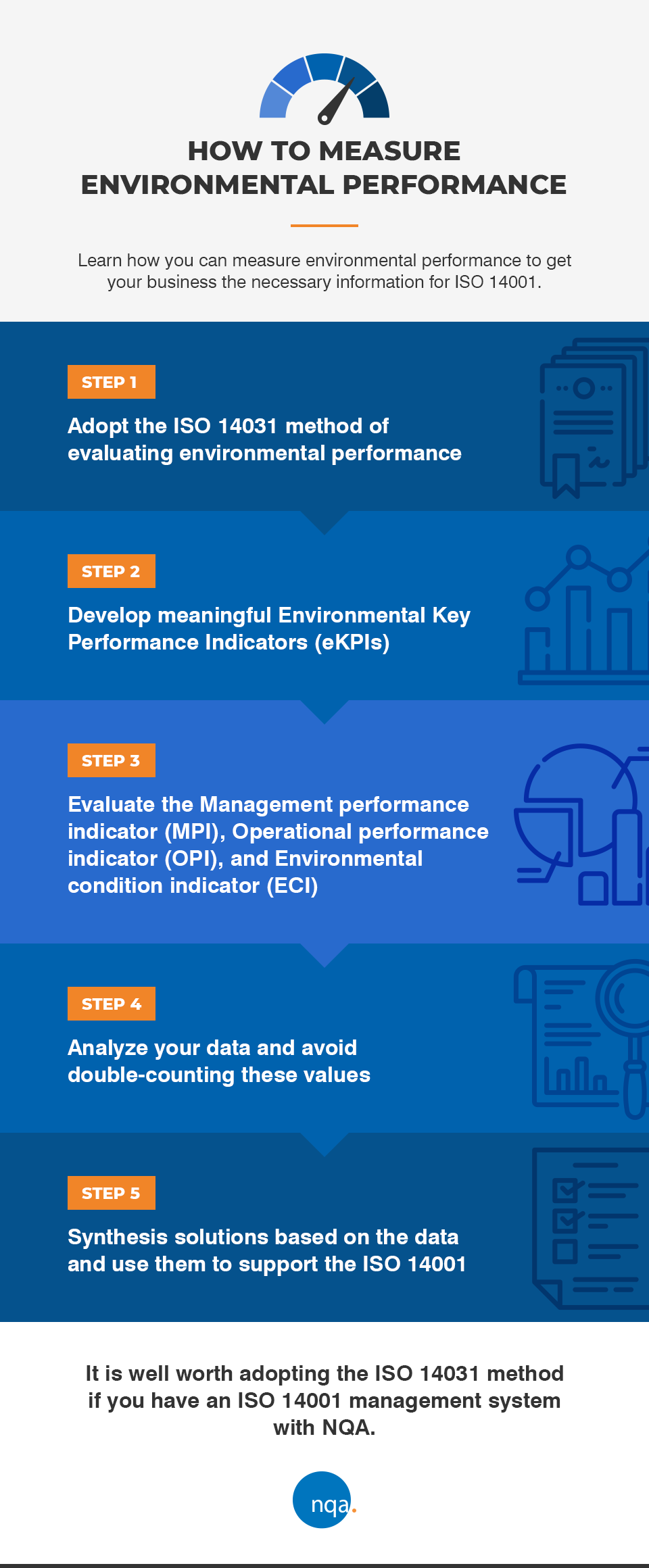
In this article we introduce ISO 14031; and provide a link between SMART objectives, effective leadership, and key performance indicators as a formula for driving environmental performance in your organization.
The method that you should apply in order to determine the environmental performance of an organization is ISO 14031. This standard provides guidance on how to conduct environmental performance evaluation in support of ISO 14001, and was first developed by the International Standards Organization in 1999. This article explores everything that you need to know in order to measure environmental performance under this standard.
According to International Standard Organization (ISO), Environmental Performance Evaluation (EPE) is a “process to facilitate management decisions regarding an organization’s environmental performance by selecting indicators, collecting and analysing data, assessing information against environmental performance criteria, reporting and communicating and periodically reviewing and improving this process”.

ISO 14031 has been describes as a “simple” environmental management system by many commentators. To some extent this is true, because this standard provides a plan-do-check-act method that enables top management to gather information on environmental performance, which is also meaningful and reliable-enough to base management decisions upon. This is illustrated by the figure below:

Environmental Key Performance Indicators (eKPIs) are the primary mechanism that can demonstrate how effectively an organization is achieving its environmental objectives. To assist you in developing meaningful KPI’s, we would suggest that you to consider these perspectives when you are planning environmental performance evaluation:
ISO 14031 distinguishes three basic types of environmental performance indictor:
1. Management performance indicator (MPI) – environmental performance indicator that provides information about the management efforts to influence an organization’s environmental performance.
Common examples: Environmental costs or budget, number of audit findings, percentage of environmental targets achieved, number of complaints from public or employees, costs of environmental damage (legal non-compliance).
2. Operational performance indicator (OPI) - environmental performance indicator that provides information about the environmental performance of an organization’s operations.
Common examples: Raw material used per unit of product (Kg/unit), energy used annually per unit of product (MJ/1000 L product), emissions of specific pollutants to air (Ton CO2/yr), wastewater discharged per unit of product (1000 L/unit).
3. Environmental condition indicator (ECI) - specific expression that provides information about the local, regional, national or global condition of the environment.
Common examples: Fish deaths in a specific watercourse over time, contaminant concentration in ground- or surface water (mg/L), concentration of a contaminant in the tissue of a specific local species (µg/Kg) e.g. shellfish, pollutant contaminant concentration in ambient air (µg/m3). This approach is particularly useful when all three types of performance indicators are used together to analyse a common problem…
A steel manufacturer has received notification from the Environment Agency that its discharge activities could be polluting a watercourse that contains otters. What might they monitor?
OPI
MPI
ECI
It should be obvious that otters, being a protected species under the Wildlife and Countryside Act 1981, are more relevant to pollution incidents due to the protection that they afford. Concentrating on the food-supply chain means that fish and associated habitats (such as otter holts and rests) becomes increasingly important to understand.
In addition, it is important to focus and gain clarity on the nature of operations within the manufacturing site, and this means that the source, pathway and receptor of pollutants need to be controlled. Hence we can also focus on preventative measures, such as drain covers, and operational control, which is indeed focussed on the ability of the organization to respond promptly to abnormal operating conditions.

It goes without saying that environmental performance indicators sometimes require calculation. Do not be afraid to adopt existing quantification methods. For example, it is quite easy to calculate the rate that an airborne pollutant is generated:

The trick to doing this successfully is to avoid double-counting these values and to focus on obtaining reliable data. Sometimes it is necessary to have independent monitoring where employee bias could affect the verity of new data.
The information derived from analysed data, expressed in terms of EPIs and possibly ECIs, and should be compared. The results of this comparison may be useful in understanding why the environmental performance criteria have, or have not, been met. Indeed, ISO 14031 is especially useful at pinpointing issues because it is designed around the logic of risk-based thinking: having more than one environmental performance indicator can be advantageous when you are looking to validate or corroborate evidence of environmental performance.
Looking again at the worked example, we may find out that otters are affected disproportionately from an activity that is not linked to wastewater, such as construction activities that could lead to loss of otter habitat. We would never have known this without the additional performance indicators, and namely the abundance of otters on the watercourse.
ISO 14031 includes guidance on both internal and external reporting and communicating to facilitate change. Another core function of this standard is how it reinforces the importance of the management review, and if you think about it, this whole process is about getting the best possible information to decision-makers within each organization. It is well worth adopting some, if not all of the principles within this standard if you have an ISO 14001 management system with NQA.